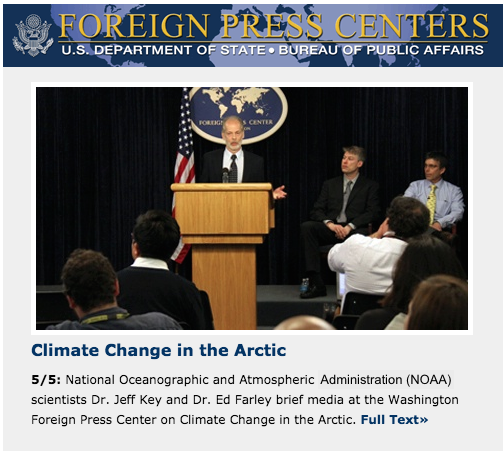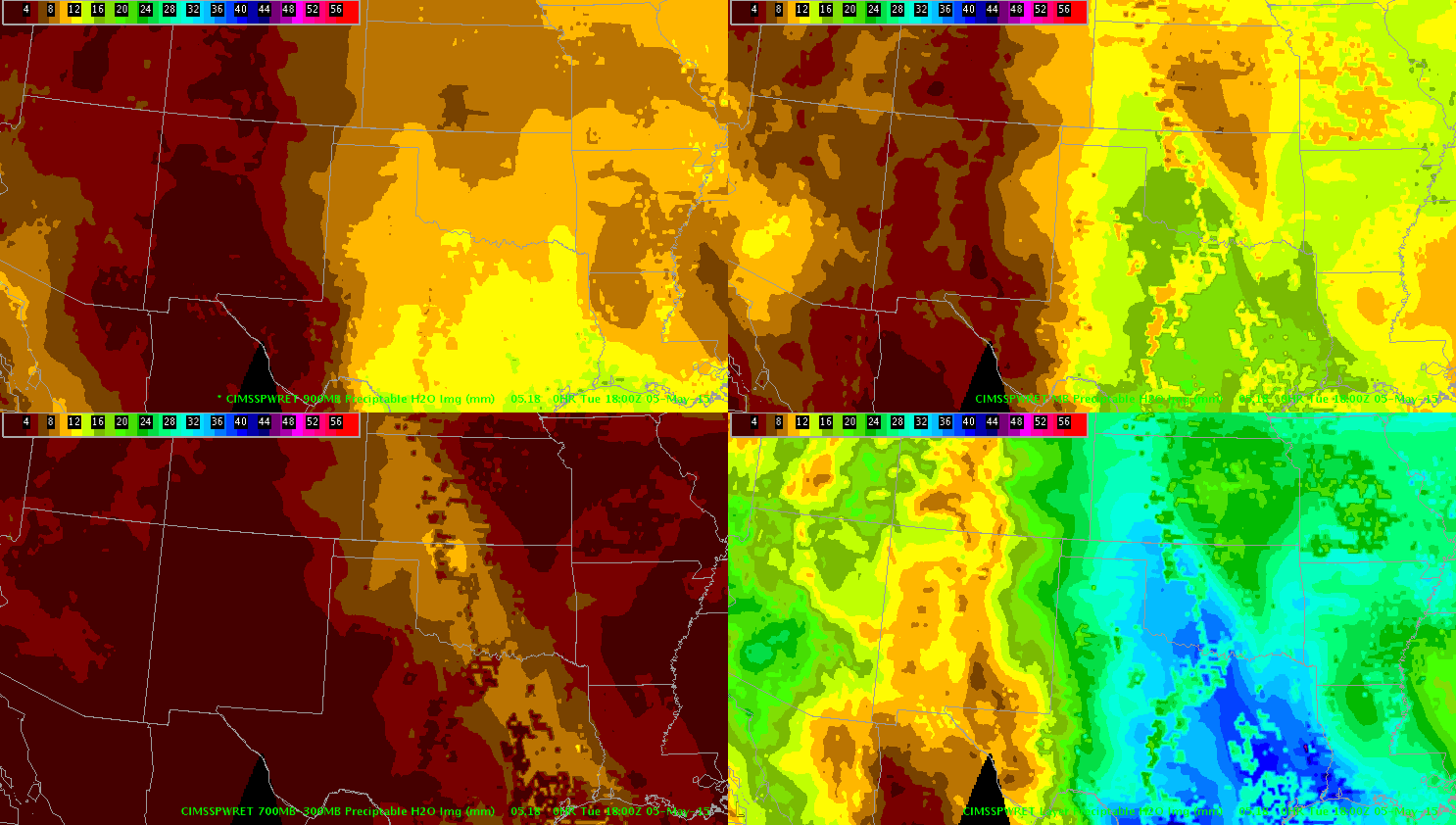
[ Archive ]

 |
CIMSS-NOAA Weekly Report
[ Archive ] |
 |
IN THE PRESS:
Foreign Press Center Briefing on Arctic Climate Change: Jeff Key (NESDIS/STAR) and Ed Farley (NOAA Fisheries) gave briefings on two aspects of recent changes in Arctic climate at the State Department's Foreign Press Center (FPC) in Washington, D.C., May 5, 2015. Key spoke on the use of satellites in detecting and quantifying changes in the Arctic climate system. Farley spoke about the impact of a retreating sea ice cover on Alaska fisheries. The briefing was attended by nine journalists from around the world, with two additional foreign journalists viewing via video-conference from the NY Foreign Press Center, and questions from US, UK and Canadian journalists who livestreamed the conference and emailed questions. A video of that briefing is available at http://fpc.state.gov/ (at the time of this report) or http://bcove.me/dtuso7fk. CBC/Radio Canada posted an article shortly after the briefing (http://www.cbc.ca/news/politics/melting-arctic-ice-changing-weather-patterns-scientists-say-1.3061988). (J. Key, E/RA2, 608-263-2605, jkey@ssec.wisc.edu)
 (Click image to enlarge)
(Click image to enlarge)
Figure caption: Picture of the Arctic change briefing from the Foreign Press Center's website.
ITEMS FOR THE ADMINISTRATOR:
ITEMS FOR THE ASSISTANT ADMINISTRATOR:
NOAA Science Days Hill Briefings: As reported earlier, Jeff Key represented NESDIS for NOAA Science Days in Silver Spring, MD, on March 10, 2015. Two of the seven Science Days speakers, Key and Ed Farley of NOAA Fisheries, returned to Washington on May 5 and briefed House and Senate staffers in two separate meetings. The theme for this installment of Science Days was "Research in a Rapidly Changing Arctic". Key spoke on the use of satellites to detect and quantify recent changes in Arctic climate. Farley addressed the impact of the changing sea ice cover on Alaska fisheries. Farley and Key also gave a briefing at the State Department's Foreign Press Center. A video of that briefing is available at http://fpc.state.gov/241352.htm. (J. Key, E/RA2, 608-263-2605, jkey@ssec.wisc.edu)
Significance: The Science Days briefings highlighted significant efforts within NESDIS to maximize the societal benefit of NOAA’s satellites through state of the art mission oriented research
Mission Goals: Serve Society's Needs for Weather and Water Information; Support the Nation's Commerce
NOAA Cross-Cutting Priorities: Sound, Reliable State-of-the-Art Research; Integrating Global Environmental Observations and Data Management
ITEMS FOR THE OFFICE DIRECTOR, STAR:
ITEMS FOR THE DIVISION CHIEF, CoRP:
NOAA/CIMSS ProbSevere at Spring Experiment: The NOAA/CIMSS (Cooperative Institute for Meteorological Satellite Studies) ProbSevere model was evaluated at 2015 Experimental Warning Program at the 2015 Spring Experiment in Norman, OK. Five National Weather Service meteorologists from different areas across the country and one broadcast meteorologist evaluated new research aimed at increasing lead time and confidence of issuing severe thunderstorm and tornado warnings. The evaluations at the experiment allow forecasters to see what works well and make suggestions for improvements with continued research. The experiment is a unique opportunity for researchers and forecasters to work directly together, which can significantly improve the research to operations and operations to research processes. For more information see blog posts from the experiment at http://goesrhwt.blogspot.com. (J. Sieglaff, CIMSS, 608.265.5357; M. Pavolonis, NOAA/NESDIS, 608.263.9597; J. Cintineo, CIMSS, 608.890.0619)
Legacy Atmospheric Profiles in Experimental Warning Program: In support of the Experimental Warning Program (EWP), part of NOAA's Hazardous Weather Testbed (HWT) in Norman, Oklahoma, the Cooperative Institute for Meteorological Satellite Studies (CIMSS) is producing and delivering derived tropospheric moisture and stability content satellite products to National Weather Service (NWS) meteorologists participating in the experiment, where new science is evaluated for operational significance. In order to provide a geographically coherent product, the satellite products are a combination of the Legacy Atmospheric Profiles (LAP) created from Geostationary Operational Environmental Satellite (GOES) Sounder data and, in sufficiently cloudy areas, numerical weather prediction model output. The LAP are a GOES R-Series baseline product. Forecaster comments during this experiment will be used to improve the product. (J. Gerth, CIMSS, 608-263-4942, Y-K., Lee, CIMSS, 608-265-0866, J. Li, CIMSS, 608-262-3755, Z. Li, CIMSS, 608-890-1982)
 (Click image to enlarge)
(Click image to enlarge)VISITORS:
NEXT WEEK:
LOOKING AHEAD:
| Archived Weeklies Page | Submit a report item |